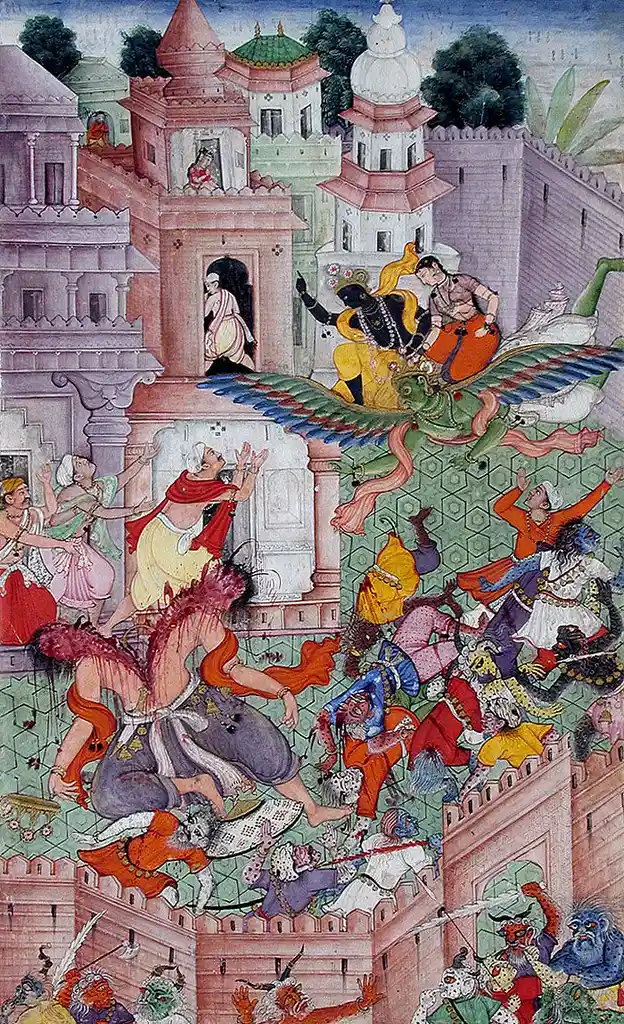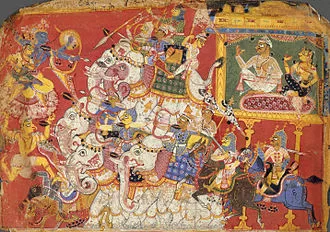Narakasura, Narak Chaturdashi, celebrated a day before Lakshmi Poojan, is an integral part of Diwali in Maharashtra, Goa, Karnataka, Telangana, and parts of Andhra Pradesh. Depending on the lunar cycle, these two festivals may sometimes coincide.
This celebration carries a profound message. Narakasura, the son of Vishnu (in his Varaha avatar) and Lakshmi (as Bhudevi), became corrupt due to his immense power. His actions disrupted the lives of common people and saints alike. Eventually, he was slain by Lakshmi (as Satyabhama) and Vishnu (as Krishna), restoring peace and justice.
ALSO READ: Dharmachakra: The Sacred Wheels of Energy
Both the Mahabharata and the Ramayana reference Naraka and his kingdom, Pragjyotisha. As per legend, Naraka’s son, Bhagadatta, fought on the side of the Kauravas in the Mahabharata war.

Early texts like the Taittiriya Aranyaka and the Shatapatha Brahmana, from the mid-first millennium BCE, mention the boar Prajapati. Over time, this figure became associated with Vishnu’s Varaha avatar, a connection that gained prominence during the Gupta period (320–550 CE).
The first mention of Varaha’s union with Bhumi, resulting in a son, appears in Book II of the Harivamsa, dated to the 5th century CE. This narrative is further elaborated in the Vishnu Purana (5th–9th century CE), where the story of their son, Naraka, is developed in greater detail.
The Rise and Fall of Narakasura
The Varman dynasty traces its origins to Naraka, as recorded in the 7th-century Nidhanpur copperplate inscription, which claims he lived three thousand years earlier. The narrative is further elaborated in the Bhagavata Purana (8th–10th century).
The most detailed account of Naraka’s story is found in the Kalika Purana (10th century), an Upapurana composed in Kamarupa. This text not only expands on Naraka’s tale but also incorporates the story of Janaka, the king of Videha and father of Sita, enriching the legend further.
Numerous manuscripts recount the story of Naraka’s birth. Earlier versions of the mythology suggest that he was conceived when Bhumi was touched by Hiranyaksha’s horns. In the Kalika Purana and other texts, Varaha is recognized as Naraka’s father.
The suffix “asura” (demon) was later added to Naraka’s name, reflecting his descent into evil after associating with the asura Banasura. Drunk with power, he brought all the earthly kingdoms under his control, convinced of his unmatched abilities. His ambitions then turned toward Svargaloka.
Narakasura, the son of Vishnu, launched an attack so formidable that even the mighty Indra was forced to flee from Svargaloka. With both the heavens and the earth under his control, Narakasura became consumed by his lust for power. He abducted 16,000 women, seized lands belonging to Aditi, and stole her jewelry.
Desperate for help, the devas, led by Indra, approached Vishnu and pleaded for intervention. Vishnu reassured them that he would resolve the situation when he incarnated as Krishna.
The Battle Against Narakasura and the Triumph of Justice
Naraka was granted a long reign, fulfilling a promise made to the earth goddess, Bhudevi. Eventually, Vishnu was born as Krishna. Aditi, a relative of Krishna’s wife Satyabhama—believed to be an incarnation of Bhudevi, Narakasura’s mother—sought Satyabhama’s help.
Outraged by Narakasura’s mistreatment of women and his actions against Aditi, Satyabhama approached Krishna to request permission to confront him. Keeping his promise to the devas and Aditi, Krishna, accompanied by Satyabhama, rode his steed Garuda and launched an assault on Narakasura’s massive fortress.
The battle was intense, with Narakasura deploying his eleven Akshauhinis against Krishna. However, Krishna effortlessly annihilated them. He also killed Narakasura’s general, Mura, earning him the title “Murāri,” meaning the slayer of Mura.
The Power of Karma and the Need for Accountability
Narakasura unleashed divine weapons against Krishna, but Krishna neutralized them with ease. According to a boon, only his mother could kill Narakasura. When Narakasura attacked Krishna with a trident, Krishna feigned unconsciousness. Enraged, Satyabhama took up arms and attacked Narakasura. In the final moment, Krishna used his Sudarshana Chakra (discus) to cleave Narakasura in two, ending his reign of terror.
Despite being the son of the supreme deities Vishnu and Lakshmi, Narakasura’s actions on earth ultimately shaped how he is remembered. It is his deeds, not his divine parentage, that define his legacy. Similarly, Prahlada, born to an asura, is remembered for his virtuous actions, which compelled Vishnu (in his Narasimha avatar) to descend to protect him. This underscores a vital truth: your karma, not your lineage, determines your legacy.
Vishnu himself set an example by punishing his own son for his transgressions, using the Sudarshana Chakra to slay Narakasura. This act illustrates that even those close to us must be held accountable for their wrongdoings. This lesson is timeless, reminding us that discipline should not be clouded by personal ties. Perhaps our leaders could benefit from revisiting such Puranic tales to guide their actions.


